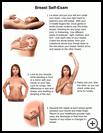
Breast Self-Exam
________________________________________________________________________
KEY POINTS
- Breast self-exam is a way to check your breasts for lumps or changes yourself.
- Talk with your healthcare provider about doing breast self-exams.
- Make sure you know what symptoms or problems you should watch for and what to do if you have them.
________________________________________________________________________
What is a breast self-exam?
A breast self-exam is a way to check your breasts for problems that may be a sign of cancer. When you do a breast self-exam, you check for lumps, thickening, and dimples in the breast. You also check for lumps in your underarms and discharge from the nipple.
Breast self-exams may be helpful for women who have had previous breast cancer to check for changes between mammograms.
What is the best time to examine my breasts?
Talk with your healthcare provider about doing breast self-exams. These exams can help you to be more familiar with your body. They can help you notice changes that need to be checked for breast cancer. If you find a lump or other changes, talk with your healthcare provider.
How do I do a breast self-exam?
- Lie down and put your left arm under your head. This spreads the breast tissue more evenly on your chest. Use your right hand to examine your left breast. With the flat part of your 3 middle fingers, press gently in small circular motions over the entire area of the breast, checking for any lump, hard knot, or thickening. Use different degrees of pressure—light, medium, and firm—to feel breast tissue at different levels in your breast. Be sure to check the whole breast, from your collarbone above your breast and down until you feel only ribs below your breast.
- After checking your left breast, put your right arm under your head. Use your left hand to examine your right breast in the same way you checked your left breast.
- Look at your breasts while standing in front of a mirror with your hands pressing firmly down on your hips. Look for lumps, new differences in size and shape, and swelling or dimpling of the skin.
- While standing or sitting, slightly raise one arm, then the other, so you can check your underarm area for lumps.
- Squeeze the nipple of each breast gently between your thumb and index finger to check for discharge or fluid from the nipples.
If you want to check if you are doing the exam the right way, ask your healthcare provider to show you how to do it.
When should I call my healthcare provider?
It is normal for your breasts to feel a little lumpy and uneven. There are also normal changes that happen to your breasts because of pregnancy, aging, menstrual cycles, taking birth control pills or other hormones, and menopause.
Most lumps and other changes are not a sign of cancer, but the only way to be sure is to see your healthcare provider. If you notice any of the following changes in your breast, see your provider right away for an exam:
- You have a new or unusual lump, whether it is tender or not.
- Your nipple is painful or starts turning into your breast.
- You have new wrinkling or dimpling of the skin.
- The nipple and surrounding skin is red or has a scaly rash.
- You have a discharge of fluid from the nipple (other than breast milk if you are breast-feeding).

